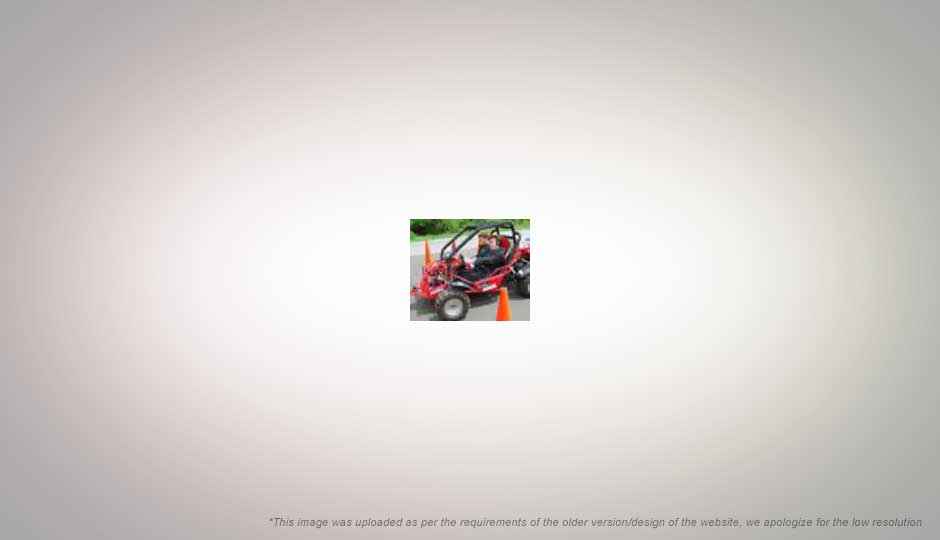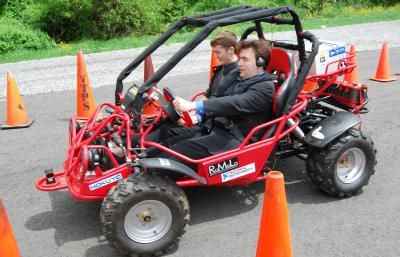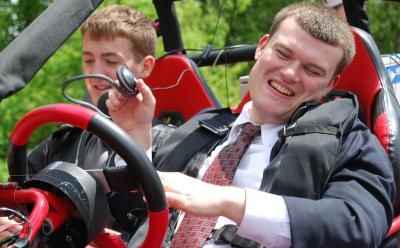New car enables the blind to drive!
By
Mihir Patkar |
Updated on 16-Jul-2009

Every once in a while, we come across a new piece of technological research that just blows us away. And the Blind Driver Challenge project by a bunch of students at US’ Virginia Tech University has to rank right up there. The team has designed a car that lets the blind and visually-impaired to drive with full control of the steering wheel and no aid from other people.
Before you read further, let the enormity of this project sink in: A person who cannot see what lies an inch from his face is about to be able to perform the complex functions of driving a car. Wow.
The team at Virginia’s Robotics and Mechanics Laboratory (RoMeLa) retrofitted a four-wheel dirt buggy to include laser range finders, an instant voice command interface and a host of other innovative, cutting-edge technology to guide blind drivers as they steer, brake, and accelerate.
One of the first blind test drivers was Mark Riccobono, the executive director of the Jernigan Institute, a research and training institute dedicated to developing technologies and services to help the blind achieve independence.

Mark Riccobono drives the Virginia Tech Blind Driver Challenge vehicle through
an obstacle course of traffic cones on a campus parking lot. Team leader
Greg Jannaman sits in the passenger’s seat, monitoring the software.
Credit: Steven Mackay, Virginia Tech
“This is sort of our ‘going to the moon’ project,” he said. “Blind people have brains, the capacity to make decisions and want to live independent lives. Why would they not want to drive?”
The idea of designing a car that gives a blind motorist complete control of the steering wheel, just like a sighted driver, threw up various challenges. For one, the laser range sensor scanning the car’s environment needs to relay the information back to the driver very quickly and accurately. So the RoMeLa team came up with a bunch of innovations.
The students developed non-visual interface technologies, including a vibrating vest for feedback on speed; a click-counter steering wheel with audio cues; spoken commands for directional feedback; and a unique tactile map interface that utilises compressed air to provide information about the road and obstacles surrounding the vehicle.
The acid test came on a closed course at the Virginia Tech campus this summer.

Wesley Majerus, the first blind person to test drive the buggy,
said the car’s instructions are more precise than a human
aide’s. The experience, he added, was liberating.
Credit: Steven Mackay, Virginia Tech
“It was great!” said Wes Majerus, also of the Jernigan Institute and the first blind person to drive the buggy. “As far as the differences between human instructions and those given by the voice in the Blind Driver Challenge car, the car’s instructions are very precise. You use the technology to act on the environment – the driving course – in a very orderly manner. In some cases, the human passenger will be vague, like saying ‘turn left’; (but) does that mean just a small turn to the left, or are we going for large amounts of turn?”
“There wasn’t a moment’s hesitation with any of our blind drivers, whereas blind-folded sighted drivers weren’t as quick to let go of their preconceptions,” said Blind Driving Challenge team leader Greg Jannaman. “The blind drivers actually performed better than their sighted counterparts. An overwhelming sense of accomplishment overcame me as I simply rode along while Wes and Mark successfully navigated the driving course without my assistance.”
But the project isn’t done yet, as the team plans to refine almost every element and make some major changes too. The first priority is to replace the dirt buggy vehicle with a fully electric car. The all-electric vehicle would reduce the vibration which can cause problems to the laser sensor, and it will provide clean electric power for the computing units and that is better for the environment.
